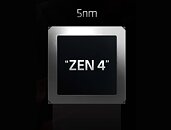
AMD Portal Entry Confirms Historical Testing of Ryzen "Rembrandt" Zen 3+/RDNA2 APUs on AM5 Platform
Over the past week or two, next-gen processor fanatics have been combing through AMD's Technical Information Portal—many truth seekers are trying to determine details of new product lineups; likely in anticipation of official unveilings (at Computex 2025). Super sleuths are still trying to find Team Red's mythical Ryzen Threadripper PRO "9995WX" processor; an alleged 96-core "Shimada Peak" range-topping beastie. Going against forward progress grains, VideoCardz has uncovered much older technologies—harking back to the days of Zen 3+ and RDNA 2. Revisiting late summer 2023, Team Red-related leaks suggested the potential arrival of (6 nm) Ryzen "Rembrandt" 6000G series desktop APUs.
We now know that AMD skipped a couple of AM5-bound steps, and eventually released its Ryzen "Phoenix" 8000G (Zen 4 and RDNA 3) family early last year. The discovery of an "AMD AM5 Functional Test Vehicle APUs (Family 19h Models 40h-4Fh) are based on the Zen 3+ 6 nm core with Radeon Navi Graphics" entry within Team Red's technical info database, has reopened online discussions about forgotten/abandoned intellectual properties. VideoCardz believes that the "19h" tag denotes "Rembrandt" family origins—additionally, their curiosity was piqued by the possibility of 6000G prototypes units escaping out into the wild. Looking ahead, the AM5 platform is expected to welcome (next-gen) Ryzen 9000G "Gorgon Point" desktop (Zen 5 + RDNA 3.5) processors.
We now know that AMD skipped a couple of AM5-bound steps, and eventually released its Ryzen "Phoenix" 8000G (Zen 4 and RDNA 3) family early last year. The discovery of an "AMD AM5 Functional Test Vehicle APUs (Family 19h Models 40h-4Fh) are based on the Zen 3+ 6 nm core with Radeon Navi Graphics" entry within Team Red's technical info database, has reopened online discussions about forgotten/abandoned intellectual properties. VideoCardz believes that the "19h" tag denotes "Rembrandt" family origins—additionally, their curiosity was piqued by the possibility of 6000G prototypes units escaping out into the wild. Looking ahead, the AM5 platform is expected to welcome (next-gen) Ryzen 9000G "Gorgon Point" desktop (Zen 5 + RDNA 3.5) processors.

























































